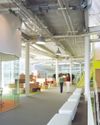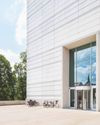What’s possible—and what’s at stake—when buildings come down.

To understand buildings, consider cities. They are evolving, iterative systems whose peripheries and hinterlands are implicated in their growth, demanding material flows of natural resources and the expenditure of energy. So too with buildings, although such thinking is relatively new. And, as urban development marches on, it is as important to analyze the embodied energy and material output of buildings when they come down as when they go up. Such flows are sometimes redirected into recycled products, but more often they terminate in landfills, waterways, or worse.
As the environmental crisis worsens, we must ask: Can we reduce our demand on new resources? Need our built environment be in perpetual flux, an endless succession of destruction and rebuilding? For Kiel Moe, professor of architecture at McGill University, the discourse surrounding demolition and recycling is “fundamental to an ethos of planned obsolescence” and isn’t “a viable way to think about sustainable construction.” Resisting this “cycle of buildings” assigns greater importance to the architectural imagination— something that should excite designers. Creative reuse, retrofitting, and, most importantly, designing programmatically versatile buildings that last should be architects’ main objectives.
But the demolition-construction cycle also entails pragmatic challenges, which may offer important—albeit fundamentally incremental—solutions to our waste predicament. Design for disassembly should become part of architectural practice, and planning to systematically sort materials during demolition can make it easier to repurpose them. The high environmental and logistical cost of removal, transportation, and processing of materials for recycling should also give pause to wrecking-ball zealots.
Denne historien er fra November/December 2018-utgaven av Metropolis Magazine.
Start din 7-dagers gratis prøveperiode på Magzter GOLD for å få tilgang til tusenvis av utvalgte premiumhistorier og 9000+ magasiner og aviser.
Allerede abonnent ? Logg på
Denne historien er fra November/December 2018-utgaven av Metropolis Magazine.
Start din 7-dagers gratis prøveperiode på Magzter GOLD for å få tilgang til tusenvis av utvalgte premiumhistorier og 9000+ magasiner og aviser.
Allerede abonnent? Logg på

No New Buildings
The energy already embodied in the built environment is a precious unnatural resource. It’s time to start treating it like one.

The Circular Office
Major manufacturers are exploring every avenue to close the loop on workplace furniture.

Signs of Life
Designers, curators, and entrepreneurs are scrambling to make sense of motherhood in a culture that’s often hostile to it.

Interspecies Ethic
In probing the relationship between humans and nature, two major exhibitions question the very foundations of design practice.

Building on Brand
The Bauhaus turned 100 this year, and a crop of museum buildings sprang up for the celebration.

Building for Tomorrow, Today
Radical change in the building industry is desperately needed. And it cannot happen without the building trades.

Strength from Within
Maggie’s Centres, the service-focused cancer support network, eschews clinical design to arm patients in their fight for life.

Next-Level Living
The availability of attractive, hospitality-grade products on the market means everyday consumers can live the high life at home.

Mi Casa, Su Casa
Casa Perfect creates a memorable shopping experience in lavish private homes.

Enter The Culinarium
AvroKO imagines the future of residential amenities—where convenience, comfort, and sustainability meet.